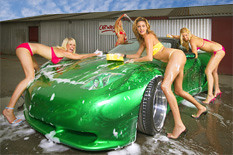Newsweek has published an article pointing out that the Toyota Hilux pickup is the most popular vehicle amongst terrorist groups and irregular militias throughout many areas of the world. Here's a short excerpt.
“The Toyota Hilux is everywhere,” says Andrew Exum, a former Army Ranger and now a fellow of the Center for a New American Security. “It’s the vehicular equivalent of the AK-47. It’s ubiquitous to insurgent warfare. And actually, recently, also counterinsurgent warfare. It kicks the hell out of the Humvee.” Anecdotally, a scan of pictures from the last four decades of guerrilla and insurgent warfare around the world—the first iteration of the Hilux appeared in the late ’60s—reveals the Toyota’s wide-ranging influence. Somali pirates bristling with guns hang out of them on the streets of Mogadishu. The New York Times has reported that the Hilux is the pirates’ “ride of choice.” A ragtag bunch of 20 or so Sudanese fighters raise their arms aloft in the back of a Hilux in 2004. Pakistani militants drive through a crowd, guns high, in 2000. It goes on. Nicaragua, Ethiopia, Rwanda, Liberia, the Democratic Republic of the Congo, Lebanon, Yemen, Iraq—U.S. Special Forces even drive Toyota Tacomas (the chunkier, U.S. version of the Hilux) on some of their deployments.
While Taliban leader Mullah Omar reportedly likes to roll in a Chevy Suburban and Osama Bin Laden is said to have preferred the Hilux’s bigger brother, the Landcruiser, when he was able to move freely, most Al Qaeda lieutenants drive Hiluxes, according to a New York Times report from the early 2000s. Even today, says Kilcullen, “It’s a bit of a sign you’re dealing with Al Qaeda when you come across them in Pakistan. They use the twin-cab version, because you can carry people and stuff in the back, and also mount a heavy weapon in the pickup.”
The truck even has a war named after it: the so-called “Toyota War” between Libya and Chad in the 1980s was dominated by fighters using the light, mobile Hilux. Indeed, Africa, says Kilcullen, is where the truck got its nickname as a fighting vehicle, “the technical.” “When [nongovernmental organizations] and the U.N. first went into Somalia,” he says, referring to a period in the 1990s, “they were not able to bring their own guards. So they got so-called ‘technical assistance grants’ to hire guards and drivers on the ground. Over time, a ‘technical’ came to mean a vehicle owned by a guard company, and then eventually to mean a Hilux with a heavy weapon mounted on the back.”
The Toyota is such a widespread and powerful weapon for insurgents, says Dr. Alastair Finlan, who specializes in strategic studies at Britain’s Aberystwyth University, because it acts as a “force multiplier.” It is “fast, maneuverable, and packs a big punch [when it’s mounted with] a 50-caliber [machine gun] that easily defeats body armor on soldiers and penetrates lightly armored vehicles as well.” It is particularly dangerous, he adds, against lightly armed special-forces operatives.
. . .
A former British special forces soldier, who asked not to be identified because he still consults on active operations, says he too has faced the Hilux, which he refers to as “the technical,” in both Iraq and Afghanistan. “I’d say the appeal is pretty simple,” he says. “You can’t underestimate the value of having a vehicle that is fast, will never break down, and is strong enough to mount a heavy weapon in the back.”
Exum, who has seen the Hilux in action across the Middle East, says the Toyota’s status is self-perpetuating. “Because everyone uses them, there are parts easily available, and mechanics everywhere know how to fix them. That kind of feeds on itself,” he says.
There's more at the link, including a gallery of Toyota pickups in various unsavory areas of the world (with equally unsavory crews).
I'm not surprised at the popularity of the Hilux. I've driven them across many thousands of miles of African bush and semi-desert terrain, and found them more reliable and trustworthy than just about anything else, including Land-Rovers, Jeeps and the like. I've always wondered why they haven't been introduced to the US market on a massive scale. They can carry an enormous load (far more than the average US pickup), they're tough as nails, and they're much more economical than the average V8-engined US equivalent (particularly when fitted with Toyota's excellent light diesel engine).
I wish US manufacturers would import a few examples of the Hilux, strip them down to component level, and study them carefully. They'd learn a lot - and hopefully they'd be able to improve their own vehicles to a considerable extent!
Peter



















0 comments:
Post a Comment